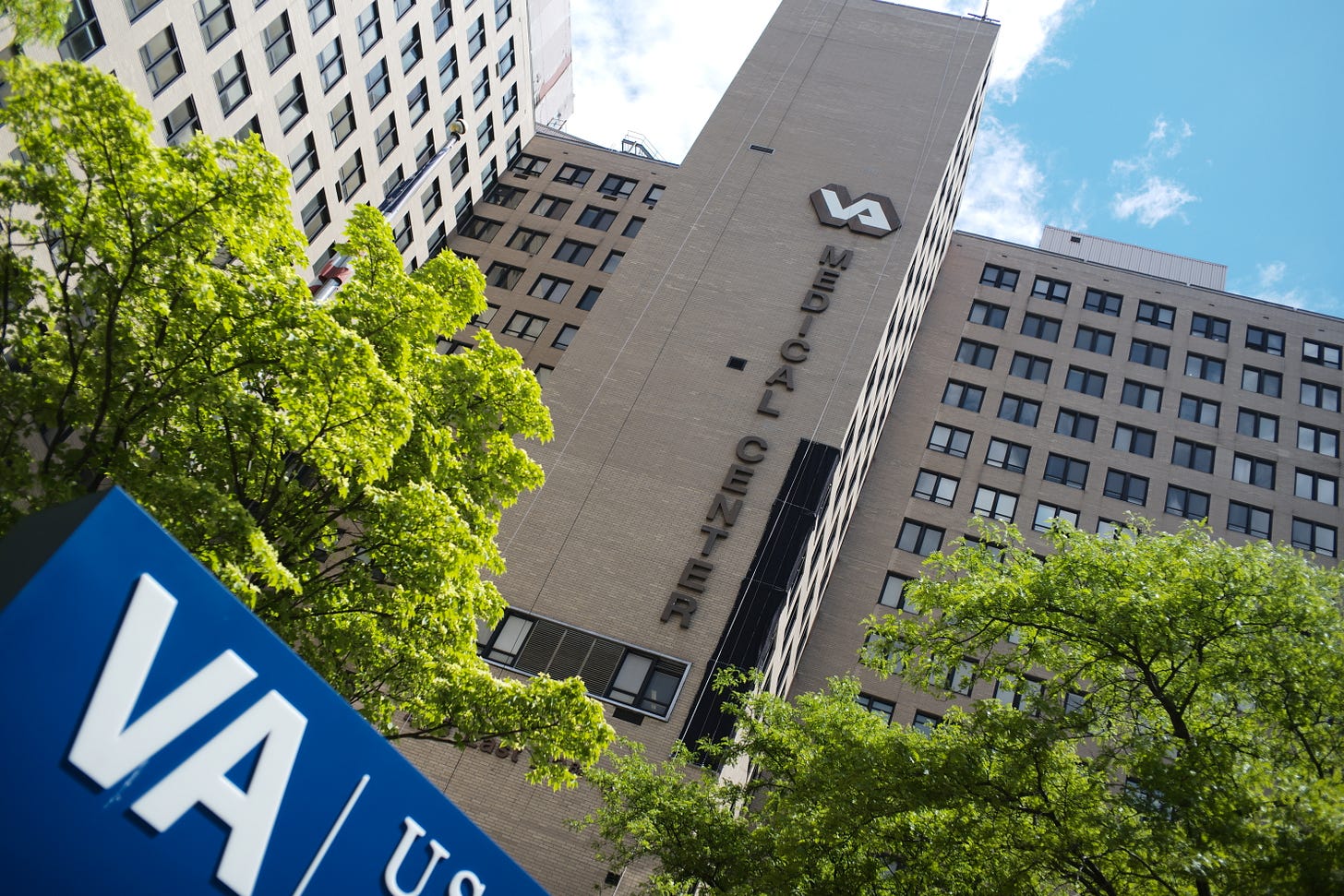For No Kings Day, Two Visions of Power
The fissures in American society will be on full display this Saturday. In Washington, Donald Trump will celebrate his 79th birthday — and the 250th anniversary of the founding of the U.S. Army — with a North Korean-style military parade that will cost an estimated $100 million.
At the same, millions of Americans who don’t want to live under authoritarian rule will take to the streets in more than 1,900 cities and towns for “No Kings Day” protests. Here in New York City, protesters will gather at Bryant Park in mid-Manhattan and march down 5th Avenue to Madison Square Park. Speeches begin at 1 p.m., and the march begins at 2 p.m. Members of the Indy team will be handing out copies of our “Fight the Bully” issue during the march.

Under Trump, there is always more money for police and the military while other government services are cut to the bone. This includes the Department of Veterans Affairs, which has been targeted by Trump for 83,000 lay-offs that would devastate the free health care millions of veterans receive. Veterans hold a revered place in America’s militaristic culture, and politicians from both major parties have long sought to win their support. So if Trump is willing to throw the vets under the bus, god help the rest of us until we get these people out of power.
Speaking of keeping corrupt autocrats out of power, early voting starts this weekend with disgraced former governor Andrew Cuomo and surging Assemblymember Zohran Mamdani locked in what is now a close two-person mayoral race. Early voting runs through June 22 with election day on June 24.
Veterans Hospitals Face Massive Layoffs
By Luce Miyar-Mullan & John Tarleton
When Army veteran Jose Vasquez received a pancreatic cancer diagnosis earlier this year, he turned to the VA Hospital on Manhattan’s East Side for a life-saving operation. “Basically a whole rearrangement of my gastrointestinal system in order to cut out the cancerous tumor,” Vasquez told The Indypendent.
Vasquez recently transferred to Memorial Sloan Kettering Cancer Center for his chemotherapy. According to Vasquez, while he was undergoing surgery at his VA hospital there was a noticeable shortage of staff. “I could just tell the nurses were spread pretty thin. … They have so many patients that they have to take care of. A lot of the vets that are being taken care of on the ward have multiple issues going on. Some of them are just fresh out of surgery. [They] have all kinds of [issues] … diabetes, high blood pressure, you name it.”
There are currently three VA hospitals in New York City — in the Bronx, South Brooklyn and on Manhattan’s East Side — with 496 beds total and an additional 120 nursing home beds. Staffing shortages are likely to grow worse. In March, a leaked internal VA memo revealed that the Trump administration is planning to lay off as many as 83,000 VA workers this year as part of efforts to shrink the government workforce being led by Elon Musk’s so-called Department of Government Efficiency (DOGE).
The move to slash the VA workforce comes just three years after Congress passed the PACT Act, which extended survivor benefits to an estimated 3.5 million veterans of the 1991 Gulf War and various post-9/11 conflicts who suffer from one of more than 20 presumptive disabilities associated with burn-pit exposure. Vietnam veterans who were exposed to Agent Orange are also covered. It was the largest expansion of veterans benefits in decades.
On April 9, the New York State Nurses Union and a number of veterans groups rallied in front of the Manhattan VA Hospital on East 23rd Street to protest the sweeping cuts.
“They have unleashed an unprecedented and immoral effort to strip nurses and other VA staff of our union rights,” said NYSNA President Nancy Hagans. “And we’re not gonna let it happen. We will not abandon our patients!”
One young trans veteran described how life-saving treatment came in the form of hormone therapy and gender-affirming care. “In 2014, I called the veteran crisis line and an actual person picked up and walked me through the process of applying for the benefits that I had earned through my service,” the veteran said. “I was on the verge of being homeless, and a few weeks later, I found the support that I needed. I started my hormone therapy, and that saved my life.”
Eleven years later, it is likely that a caller in crisis will be met with an automated voice message, as the VA’s crisis hotline is now severely underfunded and understaffed.
• • •
The United States has been fighting wars almost continuously since its inception and has, to varying degrees, come to the aid of the soldiers who fought those wars. Revolutionary War veterans were the first to receive pensions. After the carnage of the Civil War, the federal government established “soldiers homes.” Often located in bucolic rural areas, they provided lifelong medical care and housing for thousands of disabled Union Army veterans.
After World War I, the government began building new veterans hospitals with a focus on rehabilitating veterans and returning them to society. Disparate agencies were consolidated into the Veterans Administration in 1930. With 16 million veterans returning from World War II, the G.I. Bill opened up new opportunities for higher education and home ownership for veterans while the VA’s medical system was expanded and modernized and new relationships were established with research universities. This in turn fostered groundbreaking discoveries about cancer, suicide, hypertension, mental health, spinal cord injury and tuberculosis. VA innovations like the cardiac pacemaker and CT scanner benefited not only veterans but the whole world.
Veterans hold a revered place in American culture, and politicians from both major parties have long sought to win their support. In 1988, President Ronald Reagan, a bitter foe of “big government,” signed legislation elevating the VA to a cabinet-level agency. Today, according to the Department of Veterans Affairs website, it oversees the nation’s largest integrated healthcare network — 1,600 healthcare facilities, including 144 medical centers, and 1,232 outpatient sites serve nine million veterans per year. Over 25% of the VA workforce are veterans themselves.
“Veterans] need staff who know how to take care of [them],” said Veterans For Peace President Susan Schnall, a retired public sector nurse and Vietnam-era veteran who spoke at the April 9 rally. “[Doctors and nurses in the private sector] don’t understand, they can’t. … They don’t have anything to do with these folks who have been overseas … and seen armed struggle and dealt with the after effects.”
• • •
The VA health care system stands apart from the privately dominated healthcare system that most Americans experience. There are no monthly premiums, deductibles, co-pays or fees for almost all the services it provides. Conservatives have long sought to undermine this arrangement. Since 2011, the Koch Brothers funding network has poured more than $50 million into Concerned Veterans for America (CVA), which has become a leading player in the drive to privatize veterans’ healthcare under the motto of “people-empowering solutions rooted in liberty-based principles.” Its former executive director, Pete Hegseth — who now serves as Trump’s defense secretary — was ousted in 2016 amid allegations of financial mismanagement and sexual harassment.
In 2018, The Washington Post described CVA as a “muscular force” in the push to privatize the VA, while CVA-related documents obtained by the investigative website American Oversight showed that a number of former CVA officials had moved into high-level positions in the Department of Veterans Affairs. In the first Trump administration, they managed to push more outsourcing of VA services that began at the end of the Obama Administration.
DOGE’s sabotaging of the VA’s ability to serve its clients closely resembles what is happening at the Social Security Administration and other public-facing agencies that the Trump Administration wants to privatize. “[They] take the battery out of the car, say the car doesn’t work, then sell it off for parts,” a longtime VA nurse commented at the April 9 rally.
“Hospitals are incredibly complex environments to work in,” said Schnall, who was the head of quality management at Bellevue Hospital for 10 years. She worries that DOGE will force the layoff of many of the support workers — housekeepers, food preparers, radiology techs, pharma techs, the HR department that approves new hires, etc. — that make it possible for VA hospitals to function. “Politicians say they won’t lay off doctors or nurses. But, if you make the working conditions so unpleasant, they will leave.”
For Schnall, the privatization of the VA, if carried out, will inevitably fail veterans.
“The aim of private corporations is to make money for their stockholders,” Schnall said. “You cannot do that and deliver any quality of care.”




